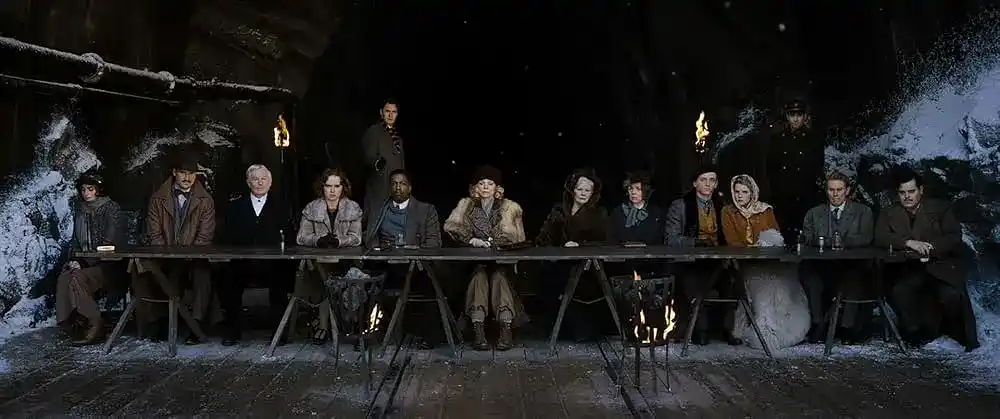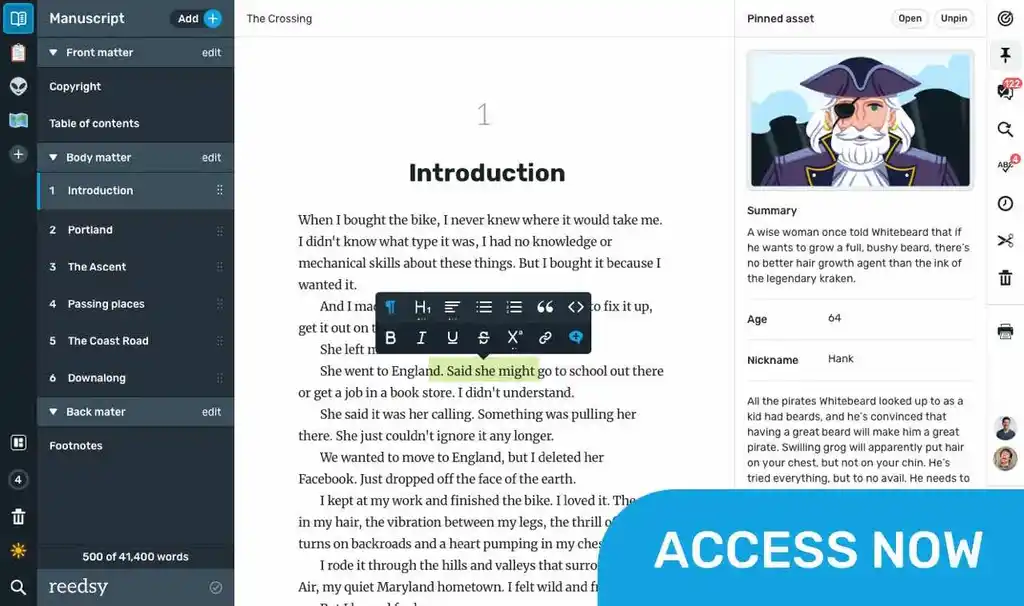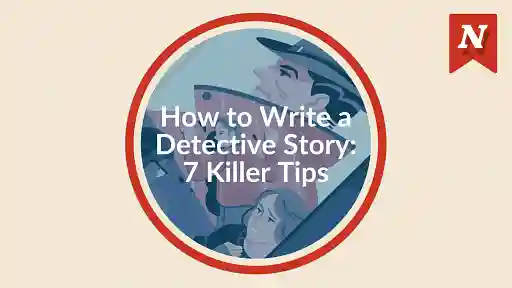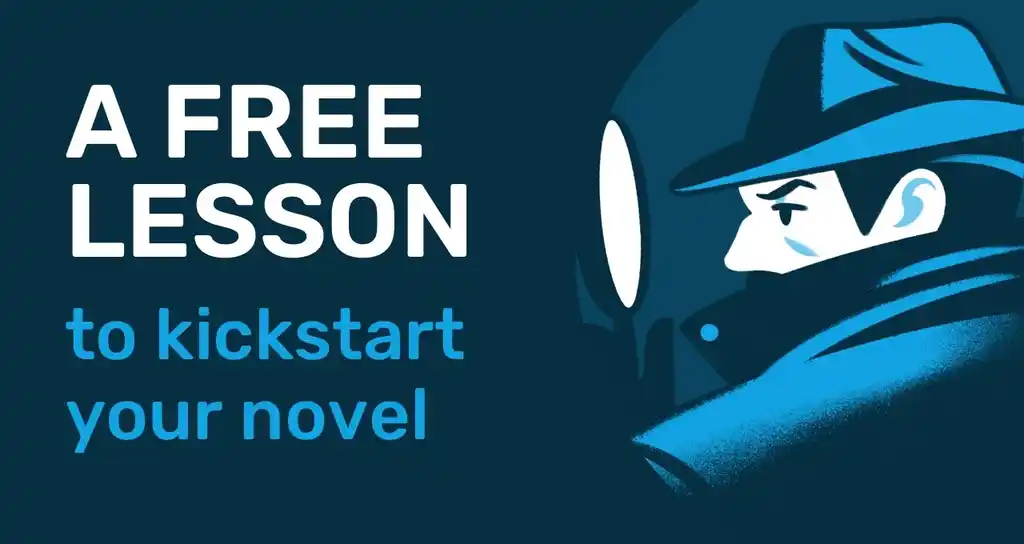Writing a murder mystery is like baking a cake: you need the right ratio of suspense, clues, and red herrings, with a surprising but welcome filling hidden in the center. In this post, I’ll walk you through all the ingredients you need to cook up a killer murder mystery (pun intended!).
1. Craft complex characters
Every story benefits from compelling and complex characters, but a murder mystery, especially so. Every suspect needs to have strong motivations, an interesting and relevant backstory, and preferably something to hide. If just the murderer concealed information, the case would be far too easy to crack — more of a “murder straightforward-y” than a murder mystery!
Agatha Christie’s Murder on the Orient Express is a great example of a book that presents a whole cast of characters with something to hide, strong motivations, and intriguing backstories. From the wealthy widow with a fabricated identity to the nervous governess desperate to protect her future, each passenger aboard the train has a unique connection to the victim and a reason to mislead the investigation.

To develop a murder mystery suspect, ask yourself these questions:
- What does my character want?
- How has their past shaped who they are today?
- What are their good and bad character traits?
- What does my character have to hide?
- What are their relationships to other characters like?
- Why is this character in my story?
You can find even more questions to ask yourself in order to get to know your characters better here.
Include the right number of suspects
If you don’t know what a particular character brings to your story, you might want to think about scrapping them! Too many suspects in a murder mystery can make the solution feel arbitrary and impossible to deduce. Remember, you should be sparing with the number of characters you include — like it or not, your reader will view everyone as a suspect, even the detective. After all, it usually ends up being the one person you thought it couldn’t possibly be!
That said, you don’t want to have too few characters either, as that could get boring. I recommend a minimum of three suspects in addition to the detective.
Now, you might be wondering: what should the maximum number of suspects be? Unfortunately, there’s no strict limit. My advice is to make sure that you aren’t just adding suspects for the sake of it, and that every character is well-developed and contributes something to the story.
Make the protagonist relatable
It’s worth pointing out that your protagonist doesn’t have to be a professional detective. In fact, some of the best fictional sleuths are amateurs, including Agatha Christie’s Miss Marple and Carolyn Keene’s Nancy Drew.
Even though the detective will be treated with some degree of suspicion, they’re still supposed to be portrayed as the most trustworthy character, and readers will think of themselves as their co-detectives. Therefore, you want them to be someone these readers can root for and relate to on some level.
M.C. Beaton’s Agatha Raisin has a messy love life and regularly clashes with her neighbors, while the retired members of Richard Osman’s Thursday Murder Club are delightfully human, each with their own sense of humor, quirks, strengths, and weaknesses.
An intriguing backstory can also help the reader sympathize with your detective. For example, Peter James’ Roy Grace is a detective whose own wife’s disappearance is the one mystery he can’t solve. This hooks readers and keeps them coming back to learn more with each new novel in the series!
2. Figure out the plot backwards
Now that you have your characters, it’s time to work on the finer details of the plot. Chances are you already know your murderer’s identity, motives, weapon, etc. But how will the detective figure it out?
Rather than plan your story from start to finish, it’s often easier to begin at the big reveal and map out how the detective gets there in reverse.
Create two timelines
You can think of your murder mystery as consisting of two stories: the story of the murder, and the story of how the detective solves it.
The latter should be told chronologically to give the reader the opportunity to solve the mystery too. However, the story of the murder will be revealed in bits and pieces throughout the narrative. To make sure there are no gaps in this story, I recommend creating a chronological timeline of the murderer’s actions; then, you can match this information up to a second timeline showing what your detective finds out and when.
Make the plot believable
An important thing to remember when outlining your plot is that it should be believable. By this, I don’t mean that it has to be realistic — there’s nothing to stop you from setting your story in a fantasy world where dragons roam — but your characters’ motivations and actions should make sense within their world.
For example, in The Seven Deaths of Evelyn Hardcastle by Stuart Turton, the time-loop premise is obviously unrealistic, but the characters’ decisions and interactions remain consistent with their knowledge, fears, and personal stakes.
Part of being believable is persuading your reader that the murderer is capable of murder through their characterization. For example, in The Secret History by Donna Tartt, the killer initially appears to be an ordinary, well-meaning college student. However, the reader comes to realize that character traits such as their arrogance and susceptibility to peer pressure make them capable of rationalizing and carrying out an awful crime.
3. Write a satisfying ending
Seeing as I’ve advised you to plot your story backward, I’ll give the rest of the tips in reverse chronological order too — starting with the ending.
Most murder mysteries have a satisfying conclusion. The case is solved, the killer is duly arrested, and all the readers’ questions are answered. (To make sure you don’t miss anything, refer back to your murder timeline.)
Avoid unpredictable coincidences
An unexpected twist is a given (more on that below), but an unpredictable ending is unforgivable.
I mean this in its literal sense — something that even Sherlock Holmes himself couldn’t possibly predict. For instance, imagine a diary conveniently falls off a shelf in front of the detective, perfectly detailing the murderer’s motives and plan. Such a contrived coincidence would undermine the detective's work and frustrate the reader.
Instead, the reader would want to feel that the solution was earned through the detective’s (and their own) efforts. For example, Sherlock Holmes’ deductions are always based on observations that readers could, in theory, make themselves.

4. Include a shocking twist
A murder mystery is only as good as its twist. A well-executed twist doesn’t just surprise — it forces the reader to re-evaluate everything they thought they knew.
The more original the twist, the less likely readers will see it coming. In one Agatha Christie novel (I won’t spoil which one!), the narrator himself turns out to be the murderer, a twist that redefined the genre at the time and left fans reeling. Now, fans are warier of narrators, but with the right amount of misdirection, I bet it could be pulled off again.
I have lots more ideas for shocking twists, but I can’t share them with you — otherwise, I wouldn’t be able to shock you with them a few years down the line!
Plant clues early on
Despite being unexpected, the best twists are inevitable in hindsight. Plant subtle clues throughout the story that point to the twist, so when it’s revealed, readers can’t help but think, "How did I miss that?" Gillian Flynn’s Gone Girl accomplishes this with a mid-novel twist that gives new meaning to seemingly throwaway lines and subtle inconsistencies in the narrative.
5. Drop clues — and red herrings
One of the joys of reading a murder mystery is piecing together the clues to try and solve the case.
Clues should be dropped into the narrative subtly, so that the reader doesn’t know what’s an important clue and what isn’t. For example, in A Study in Scarlet by Sir Arthur Conan Doyle, small details that the reader might not think anything of end up being crucial to Holmes’ deduction (again, I won’t spoil which details).
Use red herrings sparingly
As well as clues, you should include some red herrings to maintain suspense and stop the reader solving the case too quickly. However, too many red herrings can make the story feel like a wild goose chase. A good rule is to make sure each red herring serves a narrative purpose, whether it’s to reveal character traits, deepen the story’s themes, or heighten the stakes.
Treat the reader as a co-detective
The solution should be attainable, at least in hindsight. Ensure all the clues needed to solve the mystery are present in the text, and make sure the reader has all the same information as the detective. That way, the reader won’t feel cheated out of the opportunity to solve the crime.
You also shouldn’t withhold information for the sake of it. When it's revealed later, it will be obvious and the reader will get frustrated. Hide only what the characters would realistically hide — in other words, just the things that make them look bad.
6. Throw in lots of suspense
Throughout your murder mystery, you should continuously build suspense to keep your reader on the edge of their seat. You can do so in a number of ways:
Raise the stakes
One sure way to keep your reader invested is by raising the stakes. What’s at risk if the mystery isn’t solved soon? Will more people die? Will the wrong person be convicted? In Magpie Murders by Anthony Horowitz, the suspense heightens as editor Susan Ryeland becomes increasingly convinced that a fictional murder within a manuscript she is reading may have links to real life, bringing a sense of urgency to the novel.
Use cliffhangers
You can also build suspense by using cliffhangers at the end of a chapter, leaving your reader dying to read on (pun intended). In One by One by Ruth Ware, the tension escalates as each chapter concludes with a shocking revelation or an unanswered question, keeping the reader hooked as the body count rises and the true killer is revealed.
Vary the pacing
Even in the most suspenseful of murder mysteries, there are moments of relief in which the tension temporarily subsides. Use pacing to your advantage. Alternate between fast-paced, high-stakes moments and slower, reflective scenes to give the reader a chance to catch their breath. In The Reversal by Michael Connelly, the story moves between tense courtroom battles and methodical police work, creating a rhythm that keeps readers engaged while allowing for moments of reflection and analysis.
Use the setting
Your choice of setting can have a huge impact on the suspense in your story. A dimly lit mansion with countless rooms during a thunderstorm is automatically tenser than an open-plan, sunny kitchen.

7. Show, don't tell
A good mantra for any story is: show, don’t tell. Engage your readers by immersing them in the story rather than simply narrating events. Use vivid descriptions, dialogue, and actions to reveal key details and drive the plot forward.
For example, instead of stating, "The victim was poisoned," show your detective noticing a half-empty glass with a strange residue. In The Cuckoo’s Calling by Robert Galbraith (J.K. Rowling), Strike’s observations about a suspect’s behavior often speak louder than words.
Let your characters reveal their personalities, motives, and secrets in their own words. Snippets of overheard conversations or confrontational interrogations can double as both character development and plot advancement.
8. Start with an engaging hook
Finally, make sure you start your story strong. Your opening needs to grab your readers’ attention. Whether it’s the murder scene itself, an intriguing character, or a vivid setting, make your first few pages unforgettable.
In The Murder of Harriet Vane by Dorothy L. Sayers, the story opens with Lord Peter Wimsey’s determination to clear Harriet’s name when she is accused of murder. The tension and stakes are high from the outset, immediately pulling readers into the narrative as they grapple with the possibility of her innocence or guilt.
Writing a murder mystery can sometimes feel as difficult as solving a real crime! But just like finally figuring out who the killer is, crafting a complex murder mystery story is deeply rewarding. Follow these tips and you’ll be well on your way to writing a murder mystery that’s impossible to put down.
Subscribe to our newsletter
One million authors use our writing resources to get their books published. Come join them.












I wrote a murder story. It calls twin murder. The one that doing all the murders. Has a split personality and he has two separate memories. he is also telepathic. his I.Q is over two hundred.
Mario Carpanzano - Over 2 years ago
Hi Mario, thank you for sharing that about your story. It sounds an interesting premise and I like that you've woven in supernatural powers. Are you querying with your story? Good luck and thank you for reading our blog.
Jordan - Over 2 years ago
Hi. Thanks for your article. Really helpful. I am in the middle of my serial killer novel and had the bright idea of a murder committed at a city tourist attraction during broad daylight, but with no witnesses. MO is nostril pinch and mouth cover (and carving a playing card). Nice plan, but no idea about how this would be done! Any suggestions welcome!
Marc - Over 2 years ago
Hi Marc, hmm that's a challenging one. Could you have your character use a mask like we used with Covid? That was the first thought that occurred to me. I'm not sure what you mean by carving a card though? Can you explain?
Arja Salafranca - Over 2 years ago
Thanks, Arja. The card is literally lightly cutting a card into the victim so the detective knows how many, etc are coming. Clue is in the card as well. Puts time pressure on the attack. Your suggestion will work for one part of it - thanks! Decided to do a subsidiary building at a bell tower. A bit of cheese but decided on roof entry so camera didn't get anything. Later masked face caught by more distant camera. Thanks again for your reply. I wanted the utterly impossible, improbable murder but probably bit off more than I could chew! Thanks again.
Marc - About 2 years ago
You're welcome Marc! That's interesting info on the card cutting. Glad my suggestion could help for one part of it! All best with the writing.
Arja Salafranca - About 2 years ago
"How to Write a Captivating Murder Mystery" is an invaluable and expertly-crafted guide for both aspiring writers and avid readers of the genre.
Eugenia - About 2 years ago
Thanks so much for your comment Eugenia. It's wonderful to get your feedback on this blog. Happy writing!
Arja Salafranca - About 2 years ago
Your murder mystery blog is incredibly engaging and keeps me eagerly anticipating each new post. Your skill in crafting suspenseful narratives is truly impressive!
Demanding River - Over 1 year ago
Thank you for your kind feedback! It's always rewarding to hear that readers are following along. If there's anything specific you're curious about or if you have any suggestions for future posts, feel free to share. Happy reading and writing!
Dirnise At Now Novel - Over 1 year ago